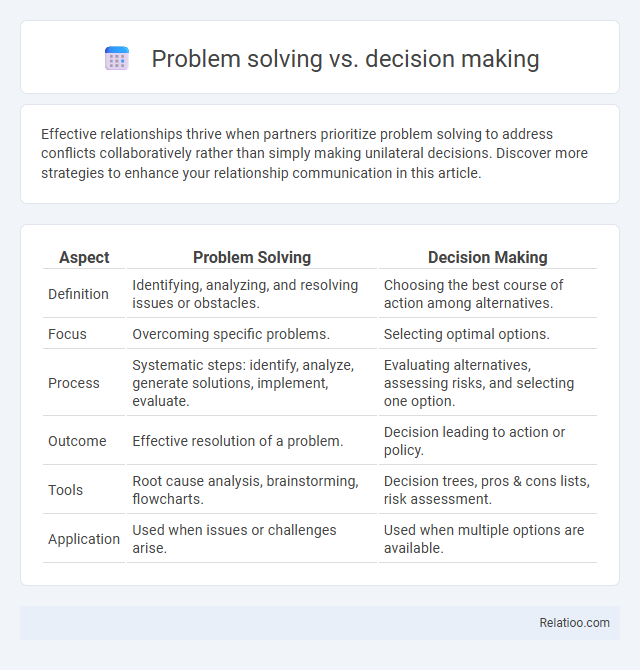Effective relationships thrive when partners prioritize problem solving to address conflicts collaboratively rather than simply making unilateral decisions. Discover more strategies to enhance your relationship communication in this article.
Table of Comparison
| Aspect | Problem Solving | Decision Making |
|---|---|---|
| Definition | Identifying, analyzing, and resolving issues or obstacles. | Choosing the best course of action among alternatives. |
| Focus | Overcoming specific problems. | Selecting optimal options. |
| Process | Systematic steps: identify, analyze, generate solutions, implement, evaluate. | Evaluating alternatives, assessing risks, and selecting one option. |
| Outcome | Effective resolution of a problem. | Decision leading to action or policy. |
| Tools | Root cause analysis, brainstorming, flowcharts. | Decision trees, pros & cons lists, risk assessment. |
| Application | Used when issues or challenges arise. | Used when multiple options are available. |
Understanding Problem Solving and Decision Making
Problem solving involves identifying an issue and developing actionable solutions to address it, whereas decision making focuses on selecting the best option among alternatives. Both processes require critical thinking and evaluation, but problem solving emphasizes diagnosis and resolution, while decision making centers on choice and commitment. Understanding these distinctions enhances strategic thinking in personal and professional contexts, such as navigating complex breakups or organizational challenges.
Key Differences Between Problem Solving and Decision Making
Problem solving involves identifying a challenge, analyzing possible causes, and developing strategies to overcome it, while decision making centers on selecting the best option from various alternatives. Your ability to solve problems requires critical thinking and creativity to generate solutions, whereas decision making primarily relies on evaluating risks, benefits, and outcomes. Understanding these key differences helps you address issues with comprehensive solutions rather than mere choices.
The Process of Effective Problem Solving
Effective problem solving involves identifying the root cause, generating potential solutions, and evaluating the best course of action before implementation. Decision making is a critical step within this process, where you choose the optimal solution based on available information and desired outcomes. In the context of a breakup, applying structured problem solving can help clarify emotions, assess relationship issues, and determine the healthiest path forward.
Steps Involved in Decision Making
Effective decision making involves a structured process: first, identifying and defining the problem clearly; second, generating a range of possible solutions; third, evaluating alternatives based on criteria such as feasibility and consequences; fourth, selecting the best option; and finally, implementing and monitoring the chosen decision. Problem solving overlaps with decision making but emphasizes resolving a specific issue through analysis and solution development. In the context of a breakup, decision making steps guide individuals through emotional assessment, weighing pros and cons, and executing a thoughtful choice toward relationship closure.
Cognitive Skills Required for Each Approach
Problem solving requires analytical thinking and critical reasoning to identify root causes and develop effective solutions. Decision making demands evaluative judgment and risk assessment to choose the best alternative among options. Breakup involves emotional regulation, self-reflection, and interpersonal communication skills to navigate relational challenges and personal well-being.
Common Barriers in Problem Solving and Decision Making
Common barriers in problem solving and decision making include cognitive biases such as confirmation bias and overconfidence, which distort objective evaluation of options. Emotional interference and stress often impair logical thinking, leading to impulsive or avoidance behaviors. Lack of clear information and poor communication further hinder effective analysis and consensus-building during these processes.
The Role of Critical Thinking in Both Processes
Critical thinking is essential in problem solving, enabling individuals to analyze complex issues, evaluate possible solutions, and implement effective strategies. In decision making, it involves assessing risks, benefits, and potential outcomes to choose the most rational option from alternatives. During a breakup, critical thinking helps evaluate emotional and practical factors objectively, facilitating clearer judgment and healthier resolutions.
Tools and Techniques for Enhanced Outcomes
Problem solving harnesses analytical tools like root cause analysis and brainstorming to identify effective solutions, while decision making relies on techniques such as decision trees and cost-benefit analysis to choose the best course of action. Breakup situations benefit from emotional regulation tools, reflective journaling, and communication frameworks to facilitate closure and personal growth. Integrating these tailored tools and techniques can improve your ability to navigate challenges, make informed decisions, and manage emotional transitions effectively.
Real-World Examples: Problem Solving vs Decision Making
Problem solving involves identifying a challenge and implementing solutions, such as when a project manager reallocates resources to meet a tight deadline, whereas decision making focuses on choosing between alternatives, like selecting the best software for a team's needs. In real-world business scenarios, problem solving might address operational inefficiencies, while decision making determines strategic directions, influencing company growth or downsizing. Breaking up, in contrast, is a personal decision influenced by problem solving when addressing relationship issues or deciding to end the partnership after evaluating options and emotional impacts.
Integrating Both Skills for Better Results
Effective problem solving and decision making are essential skills that complement each other in navigating complex challenges and personal experiences like breakups. Problem solving involves identifying the root cause and generating solutions, while decision making requires evaluating options and choosing the best course of action. By integrating both skills, you can approach breakups with clarity and emotional intelligence, fostering healthier outcomes and personal growth.

Infographic: problem solving vs decision making
 relatioo.com
relatioo.com